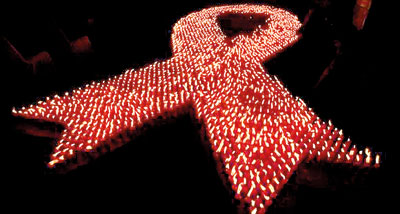Sunday Times 2
HIV pandemic’s roots traced back to 1920s Kinshasa
View(s):LONDON (Reuters) – Bustling transport networks, migrant labor and changes to the sex trade in early 20th-century Congo created a “perfect storm” that gave rise to an HIV pandemic that has now infected 75 million people worldwide, researchers said on Thursday.
In an analysis of the genetic history of the human immunodeficiency virus (HIV) that causes AIDS, the scientists said the global pandemic almost certainly began its global spread in the 1920s in Kinshasa in Democratic Republic of Congo (DRC).

About 2880 candles are seen lit during a World AIDS Day event in Jakarta( Reuters)
Here, a confluence of factors including urban growth, extensive railway links during Belgian colonial rule and changes in sexual behavior combined to see HIV emerge in Congo’s capital and spread across the globe.
Oliver Pybus, a professor at Oxford University’s zoology department who co-led the research, said that until now most studies have taken a piecemeal approach to HIV’s genetic history and looked only at certain HIV genomes in particular locations.
“For the first time, we have analyzed all the available evidence using the latest phylogeographic techniques, which enable us to statistically estimate where a virus comes from,” he said. “This means we can say with a high degree of certainty where and when the HIV pandemic originated.”
United Nations AIDS agency (UNAIDS) data show that more than 35 million people worldwide are currently infected with HIV, and some 1.5 million people died of AIDS-related illness in 2013.
Since the HIV/AIDS pandemic began, it has killed up to 40 million people worldwide.
The disease is spread in blood, semen and breast milk. No cure exists, but AIDS can be kept at bay for many years in people with HIV who take cocktails of antiretroviral drugs.
Various strains of HIV are known to have been transmitted from primates and apes to humans at least 13 times in history, but only one of those transmissions – of a strain known as HIV-1 Group M – led to the current human pandemic.
Pybus said the key questions centered on how this happened.
“Why did most of (the HIV strains) die out, and why did some of them — like HIV-2 — go on to generate local epidemics in Africa, and why did only one go to become a global pandemic?” he said in a telephone interview.
“To answer that, we needed to try to reconstruct the spread through space and time of the global pandemic strain.”
Pybus and an international team of researchers analyzed HIV-1 group M sequences from a major HIV sequence database and then combining these analyses with spatial and epidemiological data. Their study will be published in the journal “Science” on Thursday.
Philippe Lemey, a professor at Belgium’s University of Leuven who worked on the study, explained that genetic analysis had helped establish the time and place of the pandemic’s origins. The team then compared that with historical data “and it became evident that the early spread of HIV-1 from Kinshasa to other population centers followed predictable patterns.”
A key factor, the analysis suggests, was the DRC’s transport networks, particularly its railways, which made Kinshasa one of the best-connected of all central African cities.
“Data from colonial archives tells us that by the end of 1940s over one million people were traveling through Kinshasa on the railways each year,” said Nuno Faria of Oxford University, who also worked on the team.
He said the genetic data showed that HIV rapidly spread across the DRC — a country the size of Western Europe — traveling with people along railways and waterways to reach Mbuji-Mayi and Lubumbashi in the extreme south and Kisangani in the far north between the end of the 1930s and early 1950s.
The team’s findings also suggest that along with transport, social changes such as the changing behavior of sex workers and public health initiatives against other diseases that led to the unsafe use of needles may have contributed to turning HIV into a full-blown epidemic.
“We think it is likely that the social changes around the independence in 1960 saw the virus break out from small groups of infected people to infect the wider population and eventually the world,” said Faria.

